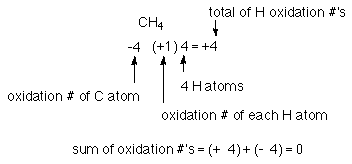Red-ox reactions
Red-ox is short for oxidation reduction reaction. The two always go together. It is not possible to have a reduction reaction without an oxidation reaction.A red-ox reaction is a reaction in which the oxidation states of some of the atoms change.
Oxidation number is a formalized way of keeping track of oxidation state.
When molecules and ionic compounds form electrons are rarely shared equally.
e.g. CF4 is held together by covalent bonds. Even though the electrons are shared, the electrons are not shared equally. Fluorine attracts electrons more strongly than Carbon, so the electrons spend more time near the Fluorine. Chemists have invented an accounting method to keep track of the electrons.
The atom that more strongly attracts the electron is "given " the electron.
in CF4 the oxidation number of the
the oxidation number of each of the
Elements: (including all allotropes) have an oxidation number = 0.
In an ionic compound
Monoatomic ions: oxidation number is the same as charge.i.e.
Group 1 elements: always have a +1 oxidation number.Group 2 elements: always have a +2 oxidation number.
When occurring in a molecule (other than an allotropic form of the element)
H always has a +1 oxidation number.F always has a -1 oxidation number.
O always has a -2 oxidation number, except when bonded to a F or another O in a molecule.
Cl has a -1 oxidation number, except when bonded to a F or an O.
Br has a -1 oxidation number, except when bonded to a F, a Cl, or an O.
I has a -1 oxidation number, except when bonded to a F, a Cl, a Br, or an O.
S has a sometimes has a -2 oxidation number, except when bonded to a F, a Cl, a Br, or an O.
What we are really saying is that the oxidation number of an atom will be the same as the charge on the ion that the element forms so long as the atom is not bonded to a more electronegative element.
For a neutral compound : the sum of the oxidation states
must be O.
For a polyatomic ion : the sum of the oxidation states must
equal the charge of the ion.
Red-ox reactions are characterized by a transfer of electrons from one atom to another, and thus a change in the oxidation state of the atoms.
The obvious reaction:
Is this a red-ox reaction?
![]()
The oxidation number of Na has gone from 0 to +1.
The oxidation number of Cl has gone from 0 to -1.
One electron was transferred from a Na (if you say "sodium" you do not need an "an"...a sodium atom) atom to a Cl atom.
In total, two electrons are transferred each time a molecule of Cl2 is consumed.
Since, the Cl atoms are gaining electrons their charge is being reduced, or made more negative.
This means that the sodium metal is being oxidized, the sodium is losing electrons.
Personally, I remember the first statement gaining electrons charge reduces or makes the oxidation state more negative.Some people like the acronym
leo goes ger lose electrons oxidize and gain electrons reduced
Another fairly obvious reaction:
Yes, this is a redox reaction.
I use the word obvious because the reactants were neutral elements, and the products were ionic compounds. It is pretty clear that electrons have moved; the Na lost an electron to become Na+.
Less obvious, but similar to rusting...combustion:
Determine oxidation numbers...
H is always +1 so,

O2 is 0
The products


So, C is oxidized. The C atom looses 8 e-'s as it goes from -4 to +4.
The oxidation number of the H atoms does not change.
The O atoms are reduced. Each O atom gains 2 e-'s as each one goes from 0 to -2. The charge is reduced from 0 to -2.
This is an important revelation. Typically, methane is burned, the heat which is produced during the combustion reaction is converted to mechanical energy, and the mechanical energy is converted to electrical energy. However, combustion is just a reaction that moves 8 e-'s from a C atom to 4 O atoms. If the e-'s can be siphoned off the chemical energy can be converted to electrical energy directly. In fact, this is the basis for fuel cells.
NASA uses the reaction of H2 with O2 for two forms of energy.
The main engines of the shuttle burn H2 in pure O2 the heat from the reaction produces rapidly expanding gases and thrust.
The shuttle produces electricity using fuel cells that convert the chemical energy of H2 and O2 directly to electrical energy.Cars which convert gasoline to electrical energy using fuel cells are being developed. The electrical energy powers electrical motors. Fuel cells would eliminate some of the problems associated with battery powered electrical cars; limited range and long recharge times. while also elimination some of the problems with internal combustion engines. Fuel cells have advantages over internal combustion engines; the fuel cells produce fewer biproducts-carbon monoxide, hydrocarbons, nitrogen dioxide, sulfur dioxide-and fuel cells are more efficient than combustion engines.